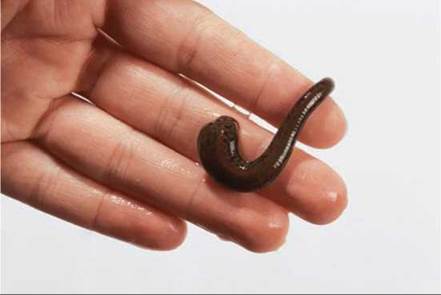CONCEPTS IN BIOLOGY
PART VI. PHYSIOLOGICAL PROCESSES
24. Materials Exchange in the Body

Leeches Used in Modern Medicine
An ancient practice returns.
For thousands of years, bloodletting was an established medical practice. It was thought that “bad blood” or a “disturbance of the humors” was the cause of many diseases and maladies and that removing blood would cure the problem. One of the established methods for removing the blood was to attach blood-sucking leeches to a person. This was such a common practice in the 1700s and 1800s that a slang term for “doctor” was “leech.” This method of bloodletting is also preserved in the scientific name of the European leech commonly used for this purpose—Hirudo medicinalis.
Today, leeches are used as an effective way to reduce swelling in patients who have had reconstructive and reattachment surgery. During these types of surgery, arteries are reattached to supply blood to the area. However, it is much more difficult to reattach veins that drain blood from the area. Thus, swelling occurs and creates a problem that can cause death of the cells in the affected parts. When fluid builds up and causes swelling, the cells in the area cannot receive oxygen and nutrients and get rid of wastes effectively. The cells die, and the surgery is a failure.
This is where the leech becomes important. An effective way to prevent swelling is to attach leeches to the affected area. The leeches rasp a hole in the skin and have anti-clotting molecules in their saliva, allowing them to feed on blood. As a result of their feeding activity, they remove the blood that builds up. This allows time for the establishment of veins and lymph vessels that carry this fluid away. As one leech becomes filled with blood and drops off, another is added until normal drainage through veins and lymph vessels is established.
• Why does swelling occur with many kinds of surgeries?
• What role do veins play in normal circulation?
• How would you convince patients that the use of leeches is a necessary part of their recovery from surgery?
ü Background Check
Concepts you should understand in order to get the most out of this chapter:
• The nature of acids, bases, salts, and buffers (chapter 2)
• The types of organic molecules and the roles they play (chapter 3)
• The structure of prokaryotic and eukaryotic cells (chapter 4)
• The concept of surface area-to-volume ratio (chapter 4)
24.1. The Basic Principles of Materials Exchange
Large, multicellular organisms, such as humans, consist of trillions of cells. Because many of these cells are buried within the organism far from the body surface, the body needs ways to solve its materials-exchange problems. Cells are highly organized units that require a constant flow of energy to maintain themselves. The energy they require is provided in the form of nutrient molecules. Oxygen is required for the efficient release of energy from the large, organic molecules that serve as fuel. Inevitably, as oxidation takes place, waste products form that are useless or toxic, and they must be removed. The five organ systems engaged in these efforts are the cardiovascular, lymphatic, respiratory, digestive, and excretory systems. All these organ systems are integrated, affecting one another in many ways. The interactions of these systems require regulation and specialization for them to maintain life.
24.1. CONCEPT REVIEW
1. Why do multicellular organisms have materials- exchange problems?